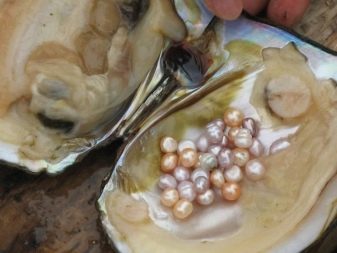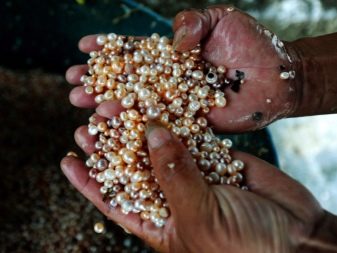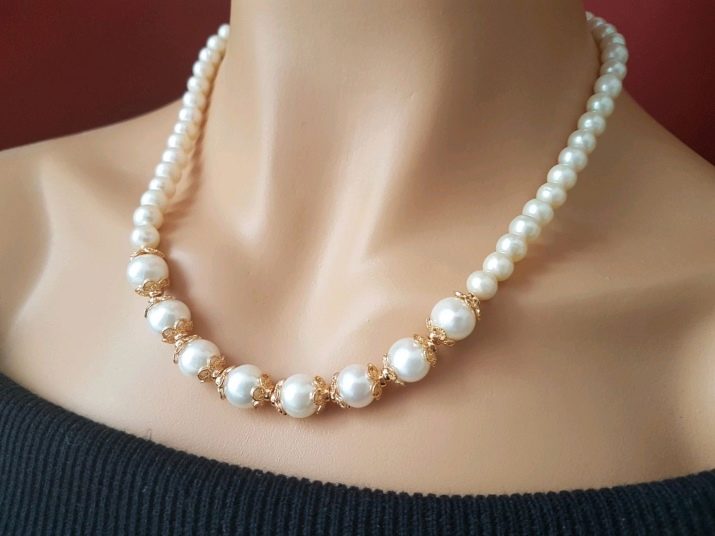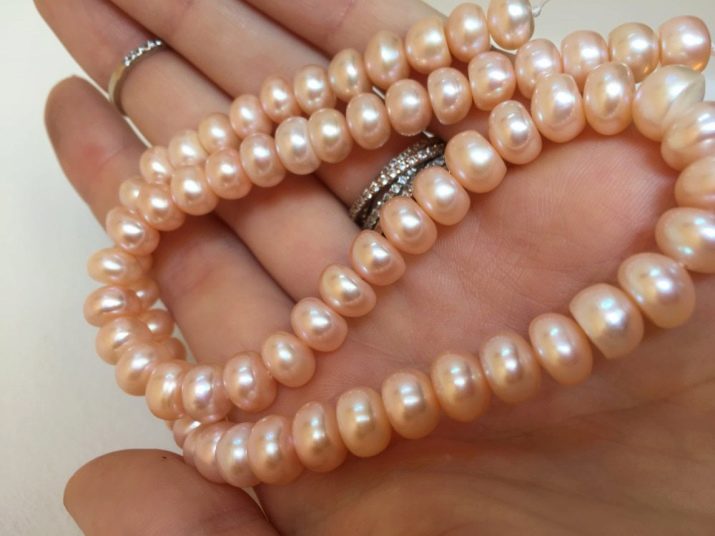River pearls: features, properties and differences from sea pearls

Pearl jewelry is quite popular among women and girls of all ages. However, not all representatives of the fair sex know that there are different types of this stone in nature: river and sea. What are the features of river pearls, how is it formed, how does the marine variety differ from the river one, what subspecies of river pearls exist? You will find answers to these and many other questions in our article.
What it is?
River (freshwater) pearl is a pearlescent gemstone that is small in size. These beads are completely natural, since no human is involved in their creation (however, to date, special pearl farms have already been created). Pearl beads are formed inside shellfish shells.
Noteworthy is the fact that mollusks grow a precious and beloved by many stone from a simple grain of sand. One shell can contain several pearls at once.


In nature, it is quite difficult to find several identical pearls, because each of them is unique in its external properties. The color, shape and some other characteristics of pearls completely depend on the particular mollusk in the shell of which they were grown. That is why on sale you can find stones that have ideal shape and proportions, but you can also find specimens that are not very attractive from an aesthetic point of view.

How is it formed and where is it mined?
Pearl beads are formed inside the shell of a clam due to the ingress of grains of sand. Due to the fact that a huge number of nerve endings are present in the body of an aquatic inhabitant, he immediately senses a foreign body, so the response follows immediately. As a defensive reaction to the ingress of a foreign element inside the shell, the oyster secretes mother-of-pearl, which overgrows a grain of sand. The period of formation of a gem is from 3 to 12 years. This period can depend on a large number of factors: the age and type of the mollusk, the state of the environment, and much more.
In cases where pearls are grown on their own, a foreign element is placed in the oyster shell on purpose. As for the extraction of pearl beads, it is carried out in several countries of the world: in Russia, the United States of America, Germany, China.
To get pearls, you need to collect mollusks and open their shells.


Varieties
In nature, there are only 2 types of freshwater pearls. They differ in the way they are grown.
- The first type is formed chaotically, without human participation. There are tremendous difficulties in relation to the extraction of such a stone. Firstly, it is quite difficult to find it, because the only indirect sign of the presence of pearls is a large concentration of freshwater oysters. In addition, it should be noted that the extraction of such precious stones is associated with great material and time costs.
- The second variety of freshwater pearls is cultured beads. These are exactly the stones that are artificially grown by people, and are presented in large quantities on the jewelry market today.
In addition, pearls can be categorized according to the color in which the beads are dyed: white, cream, pinkish, etc.


How is it different from sea pearl?
As mentioned above, in nature there are 2 types of pearls: sea and river. Both those and other stones are highly valued by jewelers and are used to make a variety of jewelry. Despite the large number of the same characteristics, sea and river pearls also have pronounced differences. Let's get acquainted with them in more detail.
- First of all, it should be said about the intensity of the brilliance of pearls.... Marine specimens shine much better and brighter. Against the background of marine representatives, river stones lose - they look duller.
- The shape of sea and river pearls is also different. Of course, there are exceptions, however, mostly freshwater specimens have a more elongated, oval shape, and sea stones, on the contrary, are rounded.
- The color characteristics of the 2 types of beads also differ significantly. The range of shades of river pearls is quite limited and ranges from white to milky. At the same time, unusual pearls can be found in the depths of the sea, which can be painted in the brightest shades (for example, black or pink).
- However, there are also indicators for which sea pearls are significantly inferior to river pearls. These characteristics include, first of all, durability. So, over time, those stones that were found in sea water can lose their luster and gloss. River specimens retain their attractive appearance for much longer. This difference is explained by the different thickness of the mother-of-pearl layer on the stones.
- In addition, one cannot fail to note that differencethat in the shell of one river mollusk you can find from 10 or more pearls, and in the shell of the sea - only 1.


Based on all the above characteristics, it is quite easy to conclude that freshwater pearls are cheaper than sea pearls. That is why many women prefer this stone.
Classic pearl beads look equally attractive no matter what kind of pearl they are made from, but the price of a river stone will be significantly lower.

How to distinguish from a fake?
Due to the fact that pearl jewelry is quite popular in the jewelry market, many scammers and unscrupulous sellers try to pass off other, cheaper materials as pearls. To distinguish a natural stone from a non-real one, you need to be guided by a few simple rules.
- First of all, it should be remembered that no matter how high-quality a fake is, it will in any case weigh less than a natural stone. Therefore, if you have several pieces of jewelry that are identical in appearance, but different in weight, then give preference to the heavier version.
- Natural pearls are a stone that is always cool to the touch. If the seller suggested that you take a closer look at the jewelry and touch it, keep in mind that the stones that will be warm are not real.
- Natural stone has special mechanical and physical properties, which are primarily related to its internal structure. So, if two natural pearls are rubbed against each other, then no marks or scratches will appear on them. In addition, if you drop a pearl on a hard surface, then it should definitely bounce off it.
- Also, when buying, carefully examine the appearance of the stone. It must be whole and have a homogeneous structure. If you notice irregularities in the color or scuffs, then you are offered a fake, so it is better to refuse any deals with such a seller.

Application
River pearls are widely used in various spheres of human life. First of all, this stone is used in jewelry that can be worn by all the fair sex, regardless of age, body type, etc. It is believed that a thin string of pearls can give an image nobility and status.

In addition, pearls are believed to have a wide range of magical and medicinal properties. In this regard, various amulets and talismans are often made from stone, which have healing and magical properties. Many psychics and people with supernatural abilities use pearls in their rituals.


Storage and care
In order to extend the life of pearls and maintain an attractive appearance of the stone for a long time, you must follow the simple rules of its storage and care of him.
- First of all, it is important to pay attention to the storage conditions of pearl jewelry (especially if you do not use them every day). Experts recommend storing river stone in a separate box or box. Thus, the stone will be in the dark and, as a result, will be protected from a large number of external negative influences. However, one box is not enough. Before placing a pearl jewelry in any container, it must be carefully packed in a fabric bag (it can be made of linen, silk or satin).
- In addition, in order to preserve the bright shine of a natural gemstone, it is necessary to take care of its timely cleaning. In no case should chemical components or aggressive cleaning solutions be used during such a procedure, as they can only harm the decoration. The ideal solution for cleaning pearls from dust and dirt is soapy.
Wipe off the beads using a soft, delicate cloth. Thus, cleaning a pearl jewelry at home is quite simple.


For the history and origins of pearls, see below.








